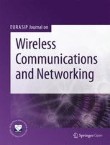EURASIP Journal on Wireless Communications and Networking welcomes submissions to the special issue on Recent Challenges & Avenues in Wireless Communication through Advance computational Intelligence or Deep learning methods.
As wireless communication becomes ubiquitous, a excess of devices ranging from smartphones to medical implants is increasingly competing for use of unlicensed spectrum. As per today's network, these radio devices may interfere with each other by limiting its real-world throughput and capacity. To overcome the hurdles and challenge, these devices must calculate the nature of the environment; define interference limits, and to predict future time samples to cancel unwanted components of a corrupted received signal. If not accounted for, interference can lead to corruption of data that leads to unnecessary retransmission of corrupted packets. Since these results in a degradation of network performance, solving the problem of wireless interference prediction will yield networks with robust performance even while multiple devices contend for limited, shared spectrum. Solving the wireless interference problem is challenging because a wireless signal can be corrupted by a variety of other ambient wireless signals, such as Bluetooth, Wi-Fi, or Long Term Evolution protocol transmissions. The environment, such as walls and obstacles, can further attenuate these signals. The net randomness can make determining wireless interference a challenging endeavor. At the same time, wireless signals may exhibit specific periodic structure and cyclo-stationary features. Modern wireless architectures have not fully realized the potential of utilizing this data to segment and predict wireless interference.
Topics of interest include but are not limited to:
- Deep Learning methods for Wireless Communication Networks
- Interference correction by deep machine learning
- Challenges and hurdles of wireless communication and its solution by machine learning methods
- Deep Belief Networks and its application in Wireless communications
- Convolution Neural networks and its applications in wireless communications
- Deep learning for Adhoc and its strategies.
- Transcend methods of implementations optimized M2M
- Machine learning for wireless communication interference, etc.
Submission Instructions
Before submitting your manuscript, please ensure you have carefully read the submission guidelines for EURASIP Journal on Wireless Communications and Networking. The complete manuscript should be submitted through the EURASIP Journal on Wireless Communications and Networking submission system. To ensure that you submit to the correct special issue please select the appropriate special issue in the drop-down menu upon submission. In addition, indicate within your cover letter that you wish your manuscript to be considered as part of the special issue on Recent Challenges & Avenues in Wireless Communication through Advance computational Intelligence or Deep learning methods. All submissions will undergo rigorous peer review and accepted articles will be published within the journal as a collection.
Deadline for submissions: 25 January 2018
Lead Guest Editor
Nagaraj Balakrishnan, Karpagam College of Engineering, India
Guest Editors
Danilo Pelusi, University of Teramo, Italy
Chin-Teng Lin, University of Technology, Australia
Subramaniam Ganesan, Oakland University, USA
Submissions will also benefit from the usual advantages of open access publication:
Rapid publication: Online submission, electronic peer review and production make the process of publishing your article simple and efficient
High visibility and international readership in your field: Open access publication ensures high visibility and maximum exposure for your work - anyone with online access can read your article
No space constraints: Publishing online means unlimited space for figures, extensive data and video footage
Authors retain copyright, licensing the article under a Creative Commons license: articles can be freely redistributed and reused as long as the article is correctly attributed
For editorial enquiries please contact amorliza.miciano@springernature.com.
Sign up for article alerts to keep updated on articles published in EURASIP Journal on Wireless Communications and Networking - including articles published in this special issue!
